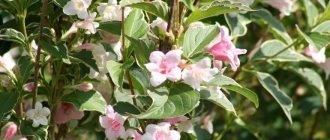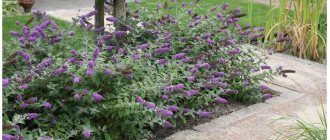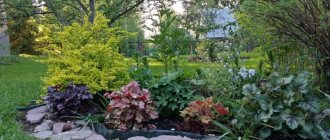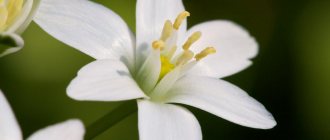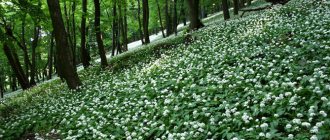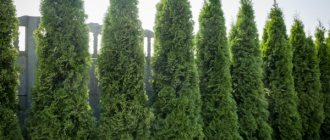Review author: Terrari School of Design
The homeland of weigela is considered to be Eastern and Southeast Asia: Siberia, the Far East, China, Korea and Japan. The plant loves moisture and shaded places, so it is not surprising that it is located on islands and coastal countries. It is represented exclusively by shrubs; there is no other form.
Despite the fact that the weigela bush is an Asian plant, it is named after the German doctor Christian Ernfried von Weigel. This explains the European and completely uncharacteristic name for local peoples.
This plant is loved by many landscape designers. First of all, because it is not so whimsical, very hardy and does not require special attention. In addition, weigels look very beautiful in the photo, which is why they are often planted in parks and placed in photo zones.
Their variety is surprising: the color can vary from white to deep purple, which gives wide scope for interesting design solutions. Therefore, planting weigela in your garden is a win-win solution; it will always find its place in any interior at any time of the year.
Main types and varieties with photos and descriptions
A shrub characterized by its unpretentiousness and resistance to minor cold snaps. There are 15 known varieties of the plant. Gardeners grow only 7 species in their garden plots. The rest are considered not attractive enough and are not used by breeders.
Photos of weigela appear on the pages of most publications on landscape design. The shrub is distinguished by lush flowering, bright foliage, and unusual buds. In the wild, the shrub grows in the Far East.
More often, gardeners grow flowering weigela or Florida weigela. It takes root better than others in regions with a temperate climate. This group includes weigela red, Alba, pink. No less popular is Weigela hybrida, Middendorf. Each variety has its own characteristics in the form of leaf blades, buds, petal color and care.
When choosing a plant variety, take into account climatic conditions. For the south of the Far East, varieties of Weigela Middendorff, early and pleasant, are suitable. These varieties do not take root in the Urals.
Early weigela or pleasant weigela (Weigela Praecox)
Weigela early stands out among other varieties due to the duration of flowering and the gray shade of the bark.
Grows up to 2 m. The upper part of the foliage is pubescent. The crown is spherical.
The buds are purple with a creamy throat. Inflorescences include no more than 3 flowers. Buds form on young side shoots of the bush.
Weigela Praecox variegated is a variegated plant. Its foliage has yellow speckles that turn creamy in color with the onset of summer. This variety is most interesting for gardeners.
Weigela Florida (Weigela Florida)
Weigela Florida is a shrub whose height can reach 2.9 m. The trunks of the shoots are covered with hairs in several rows. The serrate leaves are located on short petioles and on the front side are pubescent along the central vein, and on the back side - hairs grow on each vein.
The shrub of this variety forms inflorescences of 3 or more buds. Petals are deep pink.
Popular varieties:
- Red. It grows up to 1.6 m. The lush crown has a decorative appearance, thanks to the leaves of a brown hue with a red tint. Pink flowers with yellow throats bloom in June and July. The Nana purpurea shrub is considered similar in characteristics. The main difference is the height of the adult plant.
- Alba. The main difference is the dwarf bushes. Initially, white buds are formed. As the petals begin to wilt, they take on a pink tint.
- Variegata. Frost-resistant. The bushes of the plant are distinguished by small leaf blades. Flowers are collected in racemose inflorescences.
Pink and Victoria are flowering varieties. The first variety is distinguished by dark pink flowers with a white interior. Victoria is distinguished by purple inflorescences and decorative brown foliage with a reddish tint.
Weigela hybrida
There is no general description of hybrid weigela. Bushes of this variety are characterized by a spreading crown and lush flowering. The funnel-shaped buds exude a fragrant aroma and are located on the branches singly or in inflorescences. Petals are violet, red, white, purple or lilac.
Popular varieties include:
- Bristol Ruby. The hybrid was bred by US breeders. The height of an adult plant is 2.5-2.9 m. Weigela Bristol Ruby is distinguished by a crown whose diameter reaches more than 3 m. The foliage is bright and green. The flowers have soft pink petals with purple edges. Occasionally the throat is orange. Blooms from the end of June.
- Red Prince. An adult plant is compact in size. Grows up to 1.6 m. It has a spreading crown with drooping branches. The foliage is green and the buds are a bright red hue.
- Eva Rathke. Grows up to 1.8-2 m. The crown is spreading. Its diameter can reach 2.6-2.9 m. The branches are located tightly to each other. The buds exude a delicate aroma. Petals are carmine red. The flowering period lasts from June to August.
Weigela Middendorffiana
Weigela Middendorffiana is small in size. An adult shrub grows no more than 1.4 m.
The buds are large in size - up to 4 cm. The petals are yellow, cream or white, and the pharynx is orange. Weigela Middendorf buds are collected in inflorescences of up to 6 pieces.
This species blooms twice during one season. The buds abundantly cover the ascending shoots.
Weigela hybrids
Hybrid weigela consists of several crossed varieties that are distinguished by color and leaf shape. Hybrids are used in landscape design because they are the most decorative.
Weigela in landscape design, photo
The weigela shrub was used by gardeners in Ancient China to decorate gardens. Suitable for group plantings and designing paths. The weigela plant is used to decorate hedges or solitary plantings to attract attention.
The bush serves as a good addition to alpine slides. Weigela goes well with conifers, in compositions with natural or decorative stones.
Read about how to decorate a flowerbed with flowering plants here.
Weigel varieties
"Bristol Ruby" Quite tall bushes about 3 m. Dark pink inflorescences, dark green leaves, collected in bunches.
"Eva Rathke" The hybrid comes from Poland. Bush size 2x3 m. Red inflorescences.
"Weigela Rosea". Shrubs with large pink flowers 1.5 m high. This weigela is also decorative in the fall - the leaves turn scarlet.
Weigela: planting and care in open ground
Planting and caring for weigela in open ground takes a little time and effort. The plant is sensitive to drafts and frosts. However, it is unpretentious. The main thing is to choose the right place and prepare the soil. Caring for weigela comes down to timely watering, adding nutrient mixtures and pruning. Compliance with simple agrotechnical rules will allow you to obtain a profusely flowering, lush plant.
When is the best time to plant
Planting of weigela is most often carried out in the spring - April-May. The perennial is planted until the buds swell. The soil must be warmed up. If you follow the rules, weigela will be well accepted.
Attention! If you plant a seedling in the fall, it will die in the first winter.
If the seedling grew in a pot, it is planted in open ground throughout the growing season. When planting, the roots are not cleared from the earthen clod, but are planted along with it. This way weigela will be better accepted and adapt to new conditions faster.
Where to plant
Planting and caring for weigela requires compliance with a number of rules. Initially, choose a place for the perennial. An elevated site, without drafts, on the south side of the buildings is ideal. The plant must receive the required amount of sunlight. Otherwise, flowering will be minimal and the buds will be pale. Choose a place where there is no north wind. It is considered the main reason that weigela sheds its buds.
For active plant growth, loose soil and organic fertilizers are required. Clay soil with a neutral reaction is ideal. The best acidity indicator is 6.3-6.8 pH. Weigela is planted in a permanent place that is at least 3 years old.
Weigela Middendorf can be planted in areas with peat soil with a slightly acidic reaction.
How to plant
Weigela transplantation is carried out in several stages. Initially prepare the hole. In the selected area, dig a hole 0.3-0.4 m deep. If the soil is poor in nutrients, the planting hole is deepened another 15-20 cm.
At the bottom of the pit, a drainage layer up to 15 cm thick is made. For this, sand, broken bricks, and gravel are used. If required, lay a nutrient layer. It is made from 100 g of nitrophoska and 15 liters of rotted compost. The fertilizer is thoroughly mixed so that the plant does not get burned.
Before planting, weigela roots are treated with growth stimulants. “Radifarm”, “Heteroauxin”, “Viva+” or “Kornevin” are suitable.
The roots of the plant are carefully straightened in the hole and gradually sprinkled with rootstock, filling the voids and compacting it. The root collar is deepened by 1-2 cm so that after watering it is located at ground level. A soil mixture is used to fill the voids in the holes. It is prepared from 2 parts sand, 2 parts turf and 1 part humus. After transplantation, the plant is watered well immediately, and the trunk circle is covered with a layer of mulch. Young seedlings are watered again every 3-4 days until rooting.
If several dwarf bushes are planted, the distance between them is 0.8 m. Between tall weigelas, which grow up to 2 m high, the distance is at least 1.7 m.
How to care
Growing weigela requires timely watering, feeding and pruning of the plant. Even a novice gardener can cope with the task. During drought, water once every 7 days, but generously - up to 10 liters per plant. The number of waterings is reduced if the soil under the perennial is mulched. If the plant is planted in a pot or container, it requires frequent soil moisture.
The soil under the plant is periodically cleared of weeds and loosened. Carry out the procedure carefully. The tool should be buried no more than 10-15 cm. There is a risk of damaging the root system of the shrub.
To improve the growth of shoots, systematic pruning is carried out, removing diseased and dried branches. Disease-affected areas are cut out, and the cut areas are treated with garden varnish.
During the flowering period, the optimal temperature is 18-21 °C. The trunks and roots of immature seedlings should not be allowed to freeze. Young weigels must be covered before the start of winter. For this purpose, protective materials are used: lutrasil, sponbond. The tree trunk circle is sprinkled with sawdust, dry leaves or covered with spruce branches.
If the weigela did not survive the winter well, it is resuscitated with 10-12 liters of water, which is poured at the root of the plant.
Feeding
The weigela plant needs timely feeding.
If fertilizing was applied to the holes, they begin to fertilize the soil 2 years after transplanting.
In the third season, they begin to feed the plant in the spring. Weigela requires mineral supplements. Superphosphate, diammofoska, Kemira-lux and other synthetic fertilizers with nitrogen, phosphorus and potassium are suitable.
The second time is fed at the beginning of flower formation - late May-early June. Supplements containing potassium and phosphorus are added to the plant. Suitable superphosphate, potassium sulfate, etc. Feeding during this period allows you to get long and abundant flowering. Thanks to nutrients, weigela strengthens the branches, which makes wintering easier.
The bushes are fed for the third time during autumn digging. Wood ash is used as fertilizer. For each square meter, add at least 200 g of additive. The use of the Kemir-autumn mixture is allowed.
Diseases and pests
Weigela is an unpretentious plant that is often affected by diseases. Insects are also not averse to feasting on the lush greenery of the bush. Aphids and caterpillars pose a particular danger to weigela. During dry periods, the plant is attacked by spider mites and thrips. To combat insects, pesticides are used, for example, “Nitrophen”, “Keltan”. Infusions based on garlic, wormwood, and hot pepper are used as natural remedies.
Attention! Any synthetic preparations are used at the end of the flowering period, since the plant is a honey plant.
If the plants begin to wither, and their foliage turns yellow and falls off, the larvae of the cockchafer or mole cricket have settled in the root system. To destroy parasites, the bushes are watered with Karbofos or Aktara diluted according to the instructions.
The shrub is mainly affected by spotting, gray rot, and rust. To combat fungal and bacterial diseases, it is treated with Bordeaux mixture. This is a combination of lime milk and copper sulfate. To prevent diseases, weigela is treated with a 3% Topsin solution.
Pruning after flowering
Caring for weigela involves annual pruning. The type of procedure depends on the period and age of the plant. Young bushes undergo sanitary pruning. It is held in the spring. Thickening branches, dry and damaged, are removed from them.
Adult weigels undergo formative pruning. When the plants have not yet produced young shoots, remove old protruding branches that spoil the appearance of the crown.
If weigela has produced young shoots, formative pruning is postponed until the next season.
Once every three years, adult plants undergo rejuvenation. Branches that are 3 or more years old are pruned to the point of growth. The remaining ones are cut by a third. In some cases, all branches of the weigele are removed. After the procedure, the plant is restored.
What dried flowers can be grown in the garden, read here.
Diseases and pests
There is always a risk of encountering some difficulties when growing shrubs. This applies to both experienced gardeners and beginners.
The bush is drying up
This is a common problem that can be caused by freezing. If you can see that the bush is developing, and the appearance gives the impression of a weak plant, then most likely the problem is temperature. It is possible to cure your green friend. To do this, you need to fertilize it and treat it with Epin, which can be found in any specialty store.
If it is not possible to “pump out” the bush for a long time, then it needs to be dug up, since fresh shoots most likely will not appear.
Insects
Also, the sworn enemy of these shrubs is insects. Aphids, spider mites, caterpillars, thrips - they pose a particular threat to weigela, but the plant can be protected.
Many gardeners advise using Rogor and Nitrafen for prevention and treatment, however, despite their usefulness, if used incorrectly they can be harmful not only to the bush, but also to humans.
Common pests are also the cockchafer and mole crickets. If your green friend suddenly begins to turn yellow and weaken, but there are no visible reasons for this, then it is worth examining the root system. Perhaps there will be uninvited guests and their larvae. To avoid this, you need to check the soil and the compost with which it is fertilized.
Fungal infections
Fungal infections can be prevented. During the formation of leaves, they must be treated with a three percent Topsin solution.
Reproduction
Beginners can reproduce and grow weigela. For this purpose, cuttings, root layering and seeds are used. Planting material is purchased at the store or taken from plants from your own garden.
Cuttings
The most effective method of propagating weigela is cuttings. Young green shoots are taken for propagation. Cuttings are harvested in April-May. At this time, the formation of buds is just beginning. Select cuttings that already have several leaves. Workpieces are cut from 10 to 15 cm long. The cut is made even. Leaf blades on cuttings are cut in half.
For better rooting, the cut site is treated with a growth stimulator. "Kornevin" or "Heteroauxin" will do. The cuttings are left in a glass with the solution for 10 hours. After the specified time, the processed cut pieces are placed in a soil mixture of sand and peat. The cuttings are buried 1-1.5 cm.
Each sprout is covered with a bag or a transparent glass. A glass jar will also work. The plantings are ventilated daily by removing the cover. Water the seedlings every day, but moderately. The shoots on the cuttings must be removed.
If all the rules are followed, the root system of the seedlings will begin to form within 25-35 days. The weigela obtained in this way is transplanted to a permanent place after 1.5 years.
By layering
To propagate weigela, you can use root layering. A shoot is selected at the very bottom of the bush. The place on the branch, which is closest to the ground, is slightly incised and the bark is folded back. The shoot is bent to the soil and the injured area is fixed. To do this, make a hairpin from wire. The area with the bent bark is sprinkled with soil. Next spring the cutting will become a full-fledged plant.
Flowers
The ornamental weigela shrub delights connoisseurs of true beauty. The flowers of this plant look great against the background of emerald lawns.
Variegated or bright green leaves highlight the pleasant appearance of weigela flowers. Tubular buds up to 5 cm in size are often collected in inflorescences. There are varieties with single flowers.
Breeders have developed many hybrid varieties with buds of various shades . There is even an original variety called Carnival: on one bush there are flowers of different tones.
The color of the petals varies from soft white and cream shades to rich pink and purple variations. Some varieties have dark, purplish-red and brown buds.
The color of the buds may change during the flowering season. Weigela blooms twice a year :
- the first time in May;
- the second period is in August – September.
Why doesn't weigela bloom?
Proper care of weigela guarantees abundant flowering of the shrub. If only a few buds appear on the plant or there are none at all, it is worth reconsidering the conditions for its cultivation. The main reason for the lack of flowering in weigela is excessive pruning. Inflorescences form on branches that grew last year and this year. If you cut out active shoots, there will be no flowering.
The formation of buds and the growth of weigela are influenced by its location. If you place a shrub near trees that actively absorb nutrients from the soil and water, flowering may not occur. Weigela requires sufficient soil moisture and the presence of nutrients in it.
Flowering shrubs need sunlight and warmth. Weigela will not bloom in the shade of other plants and buildings.
On a note! If all growing conditions are met, but the shrub does not bloom, the problem is that the plant is damaged by disease or pests.
Growing conditions, features of care and reproduction
Weigela is a shrub with some peculiarities of growth conditions, care and reproduction. So, the plant loves the sun, but feels great in partial shade, and some species are adapted to shade. It prefers a loose fertile neutral substrate, although it tolerates slight acidification or alkalization of the soil.
The shrub loves frequent watering, but does not tolerate stagnation of moisture, which necessitates drainage of the substrate. Does not like low temperatures and winds. Some species are recommended to be covered for the winter, but frost-resistant varieties have also been bred. Responsive to mineral supplements. Tolerates pruning well. Resistant to pests.
It is propagated by seeds, cuttings, layering, but it is much easier to purchase one- or two-year-old seedlings ready for planting in the spring. This will help you quickly see the beauty of the flowering shrubs and decorate the space of the site.
By choosing the right weigela variety, placing the main accents in the design of the site and deciding on the company of plants in the mixborder, with proper care you can create the graceful beauty of your garden area. The use of weigela shrubs allows you to show individuality, creativity, and the ability to improvise.
After flowering
After the weigela flowers fall off, the shrub requires care. The plant needs feeding, watering and pruning. The crown of the shrub is formed by cutting off protruding branches that are weakened, dried out and diseased. After wilting, the inflorescences are removed along with adjacent branches. Otherwise, the bush will direct all its forces to the seeds.
A weakened plant must be fed. To stimulate the growth of foliage and young branches, nitrogen fertilizers are applied. This is done in the second half of July. If you apply fertilizer in the second half of August, the young shoots will not have time to become woody, which will lead to their death in winter.
During the flowering period, weigela changes the direction of sap flow. Most of the nutrients go into the buds; the buds and shoots receive a minimal amount.
Collecting seeds
The weigela bush forms seeds after flowering. They ripen in September. The seeds are collected in October. At this time, the boxes begin to open. To prevent the seeds from spilling, in September the selected seed plants are tied with gauze. After ripening, the boxes are cut off along with the tissue.
Cut the gauze over the paper. The box is opened and the seeds are dried. Then they are poured into a paper bag, on which the date and variety are noted. Store the seeds in a dark place until spring. Planting material remains viable for 1-2 years.
Plants grown from seeds may not retain varietal characteristics.
Read about which flower seriously competes with roses here.
Wintering
Caring for weigela involves preparing plants for wintering. At the end of October or early November, the tree trunk circle of the plant is sprinkled with a layer of soil 15-20 cm thick. The weigela branches are bent to the ground and fixed. The top of the bushes is covered with protective material. For this, roofing felt or spunbond is used. The material must be pressed so that it does not blow away.
There is another method of covering the plant. The branches are not bent to the soil, but tied together with twine or rope. Weigela is fenced with a mesh made of metal or plastic. Fallen leaves are poured inside the resulting structure. Additionally, the shelter is insulated with covering material.
Autumn care, seed collection and wintering
After the second flowering, charcoal is added to the soil. Other fertilizers are not recommended to be used.
During this period, seed pods with grains ripen, which should be collected by pouring the seeds onto a cloth and dried. Then the planting material is placed in a paper envelope, the name of the plant and the time of collection are written. Place in a dry, dark place for storage.
Preparing for cold weather:
- The shrub is a frost-resistant plant; some species can withstand temperatures down to -15°C, but some varieties are more susceptible to frost.
- Gardeners recommend insulating the flower for the winter: they tie a special protective cloth around the bush, sprinkle the root zone on top with leaves, and cover it with spruce branches.
Pruning adult weigela in spring
How to prune weigela, which is already considered an adult plant? In this case, gardeners carry out formative pruning in mid-summer, when the first flowering has already passed and new shoots have not yet had time to grow. Just remember that re-blooming will occur precisely on the shoots of the current year. Therefore, if you did not have time and the shoots began to grow, it is better to abandon summer pruning altogether.
How to prune weigela in the spring so that the number of buds increases each time and the growth of new shoots accelerates? In truth, this will depend on the plant variety you choose.
Remember also that anti-aging pruning is good for adult bushes once every three to four years: it involves the complete removal of all branches older than three years, and shortening those that are younger by a third.
General description of the bush
The erect weigela bush grows up to 1.5 m in height.
Some species can reach about 3 m. The shrub does not send out side shoots underground, so it always has an original shape. A huge number of elongated leaves, about 12 cm long, grow on bent branches. The edges of the plate are usually finely jagged, and the tip of the leaf is sharp. The color is traditionally green, although some species are purple or have a white edge. The inflorescences are tubular and resemble a small funnel. There are single variants and those collected in original inflorescences.
On this topic:
There are different shades, namely:
- white;
- pink;
- purple;
- light purple;
- pinkish-violet;
- red-purple.
The shoots strewn with inflorescences have a pleasant, refined aroma that creates a unique aura in the summer cottage. A detailed description and photo of weigela give a complete picture of the magnificent garden shrub for a summer cottage.
The shrub blooms in the last month of spring for almost a whole month. If you care for weigela correctly, you can admire the inflorescences at the end of August. Although there are not so many buds, the bush still causes admiration. Flowers grow only on young branches of the current season. A picturesque picture of delicate bells against a background of lush greenery can be contemplated at the dacha during the short autumn days. Autumn bloom is clearly visible in this photo of weigela; it is no worse than in summer.
Species diversity
There are 15 species of plants known to grow in natural conditions. 5 are considered cultivated and suitable for landscaping:
The growth of the bush is on average 2 meters, the crown has a spherical shape. The inflorescence consists of 2-3 flowers, drooping shape. The shades of the open corollas range from rich pink to bright red. The bud is always the same color - purple. Flowering lasts 30 days (from May to June). Planted in mixborders and as a tapeworm, against the background of a lawn. Also used as a garden planting for hedges.
Rare view. Natural habitat - Kuril Islands, Sakhalin, Primorye. The height reaches 120 cm. The leaves are green, oblong. The shade of the leaves is pink-violet, the flower has the shape of a funnel, the diameter of the corolla is 3 cm. Flowering lasts 3 weeks (late spring - early summer). Sometimes re-blooming occurs (late summer - early autumn).
A very bright and unusual bush. The green leaves have a bright and juicy hue. Used for hedges. Blooms very quickly. It reaches a height of 2-2.5 meters. The inflorescences are bell-shaped and bright red. By repeatedly pruning the crop, you can provoke flowering a second time.
Originally from the land of the rising sun. The flowers are bright red. Color twice, almost continuously. Between the first and second period there is an interval of 2-3 days. The shrub is low - 90-100 cm, 160-180 cm wide. The buds are decorated not only with young, but also with old shoots. Gardeners also use this variety for planting in flowerpots, pots and flower pots.
The culture is created for growing in the garden. The bush reaches 1-1.5 meters. The leaves are bright green, with a drooping shape. The flowers are gray-yellow with orange splashes. It blooms twice: in spring (in May) and at the end of summer (in August). Duration 20 days. In landscaping it is used as a lawn decoration, planted under tall trees with an openwork crown.
Smart cultivation
If you decide to plant weigela on your site, you need to take into account that this plant is afraid of low temperatures and winds. This feature is typical for both ornamental species and wild shrubs. Therefore, in order not to lose the decorative qualities of the plant, before planting weigela, you should take care in advance of shelter in case of severe frosts.
When choosing a location and creating shelter from frost, it is important to take into account the light-loving nature of the shrub. Most varieties do not tolerate shade at all. A lack of sunlight will cause the weigela to lose its decorative properties, fade and stop blooming.
Neutral soil is suitable for growing the crop. If the acidity of the soil is high, it is worth reducing it with lime or dolomite flour. If you have heavy and clayey soil on your property, I recommend diluting it with sand and turf soil to avoid water stagnation.
Preparing a planting pit for weigela
I plant weigela bushes in the spring, around the second half of April. I dig holes with a shovel at a distance of 2 meters. At the bottom of the holes I lay out drainage - a layer of gravel, broken brick, or expanded clay.
Weigela needs organic feeding, so when planting I apply phosphate and potassium fertilizers, 60 grams for each bush. Planting is carried out traditionally - the plant is carefully placed in a hole and covered with soil. In this case, the neck should remain at soil level.
Combination with other plants
Weigela is not a whimsical plant; it goes well with many crops, complementing and emphasizing their decorative properties. The most popular combinations with weigela:
When choosing plants for group planting with weigela, you should take into account their growth and trim them on time. The condition of the mixborder plays an important role in its decorativeness. When planting several types of flowering shrubs, “neighbors” are selected according to the duration and frequency of flowering. By choosing several crops that bloom one after another, you can create a living composition. Different flowering periods will change not only the shade of the mixborder, but also its height and volume. Proper organization of the composition will create a closed space in an open space. This is the so-called “green room effect”.
Weigela care
Caring for adult weigels consists of fertilizing, pruning, watering and loosening.
Top dressing
This shrub is fed 3 times per season.
- The very first fertilizing is carried out in the snow, before the beginning of the growing season. Mineral fertilizers are scattered around the bush within the radius of the tree trunk circle. Superphosphate and urea are best suited for this.
- The weigels are fed the second time during the formation of buds. For this purpose, potassium fertilizers without chlorine or complex mineral fertilizers with approximately equal amounts of nitrogen, potassium and phosphorus are used.
- The last time the bushes are fertilized is at the end of summer. Potassium should predominate in the fertilizers used during this period. This will help the shoots ripen and prepare the plants for winter.
Watering
In nature, weigela grows in the monsoon regions of East Asia, where the soil contains a lot of moisture. The soil should not be allowed to dry out too much; this leads to a sharp deterioration in flowering and prevents the good development of plants. The bush is watered regularly and be sure to cover the ground around the bush with a thick layer of mulching material (sawdust, husks, peat).
Loosening
Loosening is carried out as the soil around the bush compacts during the season. It should be taken into account that the weigela roots in the tree trunk lie at a depth of 8-10 cm, and disturbing them is undesirable and even dangerous. Therefore, loosening should not be carried out deeper than 8 cm.
Trimming
Pruning of this crop is carried out in early spring and July. In April, dry, frozen, broken and deformed branches are cut out, and in July, faded and old branches are cut out. In addition, in June, excess root growth is removed.
If after winter it turns out that one of the main shoots has frozen, it is cut off, leaving 10 cm above the ground. A living bud at the root will give rise to a new shoot.
Preparing for winter
When growing weigels in our country, with the exception of the southern and subtropical regions, they need shelter for the winter.
The shrub is wrapped in spunbond, and the trunk circle is covered with leaf litter or spruce branches. In the middle zone, the shelter is removed in early April.
How to properly prune young weigela in spring
Of course, like any other bush, this plant undergoes mandatory pruning. Sanitary pruning of weigela in spring is prescribed for young shrubs: the procedure involves removing diseased, broken, frozen and thickening branches.
The main pruning of weigela is carried out for decorative purposes in the summer. This procedure can be performed in the spring, but only for prevention.
To understand how to trim weigela, wait until the buds begin to swell. Only then will you be able to assess the scope of the upcoming work.
And now we offer you step-by-step instructions on how to trim weigela correctly:
- First, you should carefully examine the branches of the bush.
- Then you need to find weak or frozen shoots.
- Naturally, delete them.
- Those shoots that are partially frozen, simply cut them off to the outermost healthy bud.
Do not forget that in the spring only sanitary pruning is carried out. You need to give the remaining shoots time to grow until the summer.
By the way, another piece of advice that experts often give is as follows: even if the whole shoot is frozen, when pruning, leave a small part of it (no more than 6 cm), which is closer to the ground. There is a possibility that a bud located close to the soil will still wake up and become a strong shoot.

